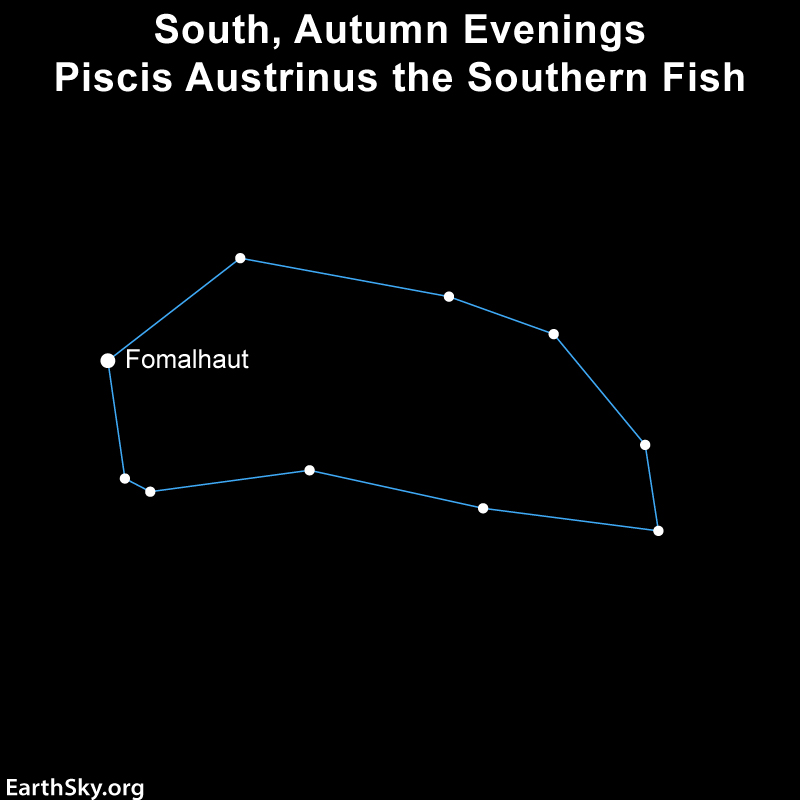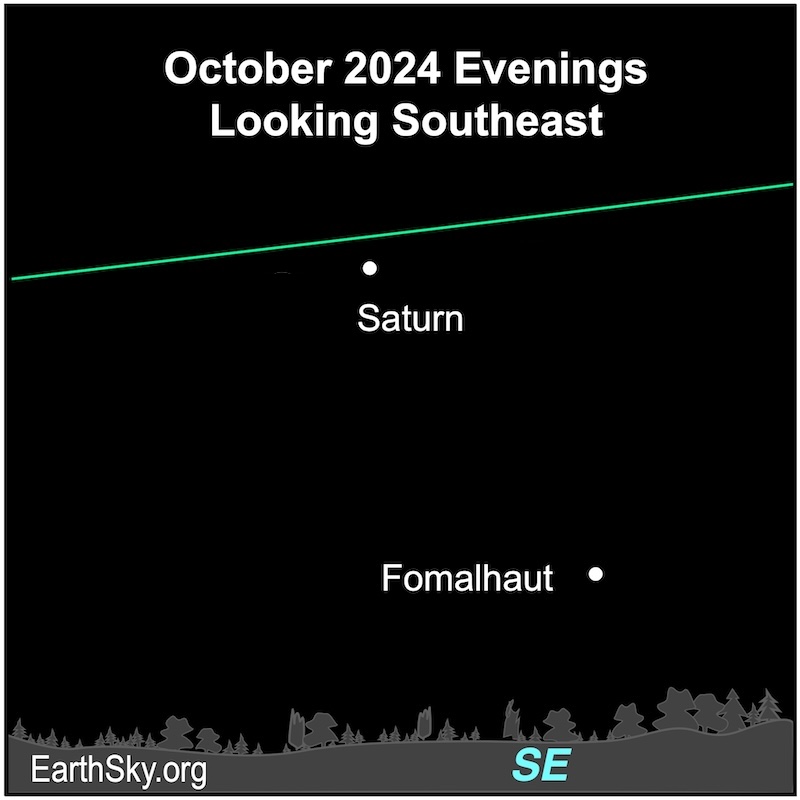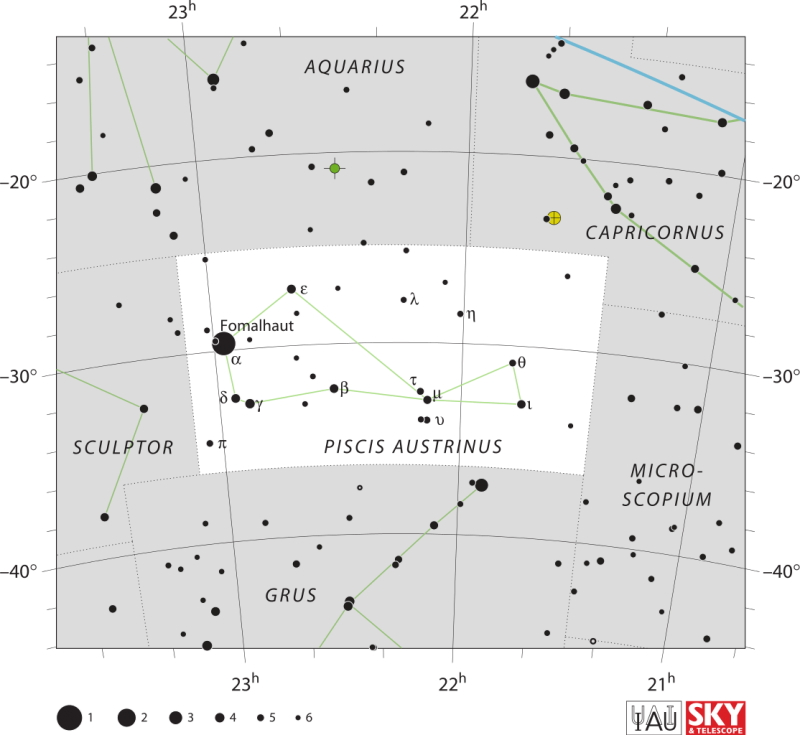
Piscis Austrinus has few bright stars and very faint deep-sky objects. The constellation of the Southern Fish is close to Capricornus in the spring sky for those in the Southern Hemisphere. Northern Hemisphere residents who don’t live too far north and want to catch a peek of this constellation can look below the constellations Capricornus and Aquarius in the fall. Piscis Austrinus has a vague, kite-shaped, fishlike form.
Piscis Austrinus was one of the 48 constellations that Ptolemy named in the 2nd century. The constellation was once larger, containing the stars that are now part of Grus the Crane.
Its only bright star
Piscis Austrinus has one very bright star: Fomalhaut. Fomalhaut, also known as Alpha Piscis Austrini, is magnitude 1.17 and lies 25 light-years away. Its name means the mouth of the fish in Arabic. Fomalhaut is the 18th brightest star in the sky. It is a white, A-type star.
In 2024, the bright planet Saturn can help you find Fomalhaut.

Other stars of Piscis Austrinus
The next brightest stars in this constellation are magnitude 4.1 Epsilon, magnitude 4.2 Delta, magnitude 4.2 Beta and magnitude 4.3 Iota Piscis Austrini.
In the farthest southeastern corner of the constellation boundary is a star known by a few names, including Lacaille 9352 and GSC 7512:12363. Lacaille 9352 is unremarkable at magnitude 7.3, but it is one of the closest stars to the sun at 10.72 light-years away. This red dwarf is also notable in its proper motion. As one of the fastest-moving stars known, it travels at approximately 75 miles per second (120 kilometers per second).

A faint fuzzy in Piscis Austrinus
The deep-sky objects in Piscis Austrinus are all very faint. One of the “brightest” of these faint fuzzies is NGC 7314, a spiral galaxy at magnitude 10.9.
Bottom line: Piscis Austrinus the Southern Fish is notable for its one bright star, Fomalhaut. From the Northern Hemisphere, look south in autumn to find it. From the Southern Hemisphere, look high overhead.
The post Meet Piscis Austrinus the Southern Fish and lonely Fomalhaut first appeared on EarthSky.
from EarthSky https://ift.tt/8hlPj0N

Piscis Austrinus has few bright stars and very faint deep-sky objects. The constellation of the Southern Fish is close to Capricornus in the spring sky for those in the Southern Hemisphere. Northern Hemisphere residents who don’t live too far north and want to catch a peek of this constellation can look below the constellations Capricornus and Aquarius in the fall. Piscis Austrinus has a vague, kite-shaped, fishlike form.
Piscis Austrinus was one of the 48 constellations that Ptolemy named in the 2nd century. The constellation was once larger, containing the stars that are now part of Grus the Crane.
Its only bright star
Piscis Austrinus has one very bright star: Fomalhaut. Fomalhaut, also known as Alpha Piscis Austrini, is magnitude 1.17 and lies 25 light-years away. Its name means the mouth of the fish in Arabic. Fomalhaut is the 18th brightest star in the sky. It is a white, A-type star.
In 2024, the bright planet Saturn can help you find Fomalhaut.

Other stars of Piscis Austrinus
The next brightest stars in this constellation are magnitude 4.1 Epsilon, magnitude 4.2 Delta, magnitude 4.2 Beta and magnitude 4.3 Iota Piscis Austrini.
In the farthest southeastern corner of the constellation boundary is a star known by a few names, including Lacaille 9352 and GSC 7512:12363. Lacaille 9352 is unremarkable at magnitude 7.3, but it is one of the closest stars to the sun at 10.72 light-years away. This red dwarf is also notable in its proper motion. As one of the fastest-moving stars known, it travels at approximately 75 miles per second (120 kilometers per second).

A faint fuzzy in Piscis Austrinus
The deep-sky objects in Piscis Austrinus are all very faint. One of the “brightest” of these faint fuzzies is NGC 7314, a spiral galaxy at magnitude 10.9.
Bottom line: Piscis Austrinus the Southern Fish is notable for its one bright star, Fomalhaut. From the Northern Hemisphere, look south in autumn to find it. From the Southern Hemisphere, look high overhead.
The post Meet Piscis Austrinus the Southern Fish and lonely Fomalhaut first appeared on EarthSky.
from EarthSky https://ift.tt/8hlPj0N

Aucun commentaire:
Enregistrer un commentaire